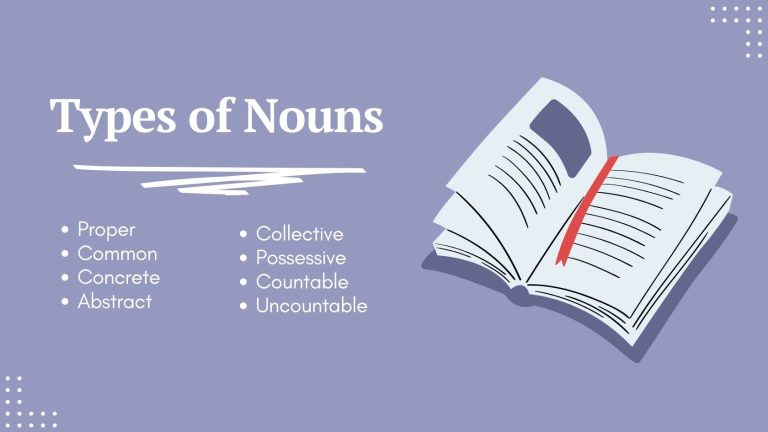8 Types of Nouns

Nouns are the building blocks of language. They name everything: people, places, things, and ideas. From proper nouns to collective nouns, let’s look at the 8 types of nouns.
1. Proper Nouns
Proper nouns are the specific names of people, places, or things. They always start with a capital letter. For example, when we talk about cities like Paris or people like Emma, we’re using proper nouns. They help us pinpoint exactly what or who we’re talking about.
Proper nouns stand out because they show respect and recognition. Using them correctly in writing and speaking shows that we understand and honor the uniqueness of each name. This is why names of days, months, and historical events also use capital letters.
2. Common Nouns
Common nouns are the general names for things, people, places, or ideas. They don’t start with a capital letter unless they’re at the beginning of a sentence. Common nouns are words like “city” for any city or “dog” for any dog.
These nouns are all around us and make up most of what we talk about. They’re the everyday words we use to talk about a type of thing without specifying which one. For example, “tree” is a common noun that could mean any tree, anywhere.
3. Concrete Nouns
Concrete nouns name things you can touch, see, smell, hear, or taste. They’re all about the physical world. For example, “apple” and “music” are concrete nouns because you can see an apple and hear music. These nouns ground our conversations in reality, talking about actual things around us.
So, when we chat about a “car” or a “flower,” we’re using concrete nouns. They make our words more vivid because they connect with our senses. They help us share our experiences and the world around us in a way everyone can understand.
4. Abstract Nouns
Abstract nouns are the opposite of concrete nouns. They name things you can’t touch or see. Instead, they’re about ideas, feelings, or concepts. Words like “love,” “freedom,” and “happiness” are abstract nouns. They’re not physical, but they’re very real to us because they describe emotions and ideas that matter in our lives.
These nouns give depth to our conversations and writings. They also allow us to express complex thoughts and feelings. When we talk about “courage” or “time,” these are concepts that don’t have a physical form. But they’re still essential parts of our experience and our inner lives.
5. Collective Nouns
Collective nouns are special. They name groups of people, animals, or things as a single entity. For example, a “team” refers to a group of players, and a “flock” refers to a group of birds. These nouns let us talk about many individuals as one unit.
When we use collective nouns, we highlight how individuals come together to form a collective with a shared identity. Whether it’s a “class” of students or a “choir” of singers, these nouns emphasize unity and collaboration. They show us the power of coming together, transforming many into one.
6. Possessive Nouns
Possessive nouns show ownership or belonging. They tell us who or what something belongs to. We often form them by adding an apostrophe and an “s” to the end of a noun, like in “dog’s leash” or “Emma’s book”. This small change signals that the item is owned by someone.
This type of noun is key for expressing relationships and possessions in language. It helps us understand the connections between people and things. For example, saying “the teacher’s pen” instantly shows the pen belongs to the teacher.
7. Countable Nouns
Countable nouns are items you can count. They let us say exactly how many of something we have, like “three cookies” or “ten trees”. You can have one, two, three, or more of them. Countable nouns can be singular or plural, and when they’re plural, we usually add “s” or “es” at the end.
These nouns are great for when we need to be specific about quantities. They help in planning, shopping, and many other activities where numbers matter. For instance, knowing if you have “five apples” helps decide if you can bake an apple pie.
8. Uncountable Nouns
Uncountable nouns are about things you can’t count individually because they’re seen as whole or mass items. Words like “water,” “sand,” and “happiness” are uncountable. They don’t have a plural form and you can’t use “a” or “an” with them. Instead, we talk about these nouns in terms of amount, like “some water” or “a lot of sand.”
These nouns are key for talking about substances, concepts, or feelings that don’t break down into countable units. They help us express ideas about things that are too vast or abstract to count. For example, “air” is essential to life, yet we can’t count it. That means uncountable nouns can often be intangible aspects of our world.
Quantifiers help us talk about how much of something we have. With uncountable nouns, we use special words such as “a lot of water”.
Types of Nouns
Exploring the types of nouns has shown us how varied they are in our language. From naming specific things with proper nouns to talking about general stuff with common nouns, each type has its own job.
We’ve also looked at how collective nouns bring things together, how possessive nouns show who owns what, and how countable and uncountable nouns help us talk about how much of something there is.
Getting to know these eight types of nouns helps us improve our writing. They also make our ideas clearer. Let us know what you think about your favorite type of noun.
